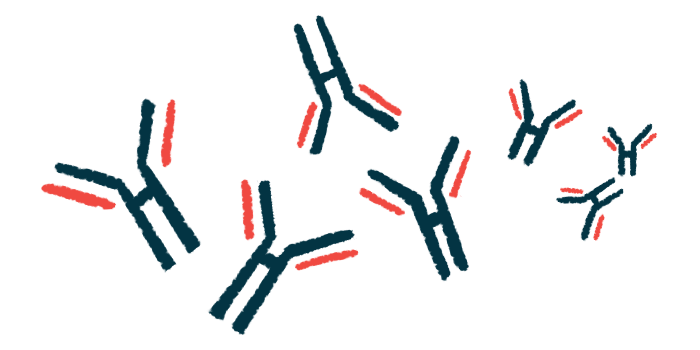Antinuclear antibodies linked to more severe NMOSD
Assessing ANAs may be used as a biomarker for poor prognosis

The presence of certain self-reactive antibodies called antinuclear antibodies (ANAs) in the blood is associated with worse disability and more severe relapses in people with neuromyelitis optica spectrum disorder (NMOSD), according to a study from China.
“Our results suggest that ANA seems to be more associated with severe disease activity and poor prognosis in NMOSD patients, which further implies that ANA may be able to be used as a prognostic marker in NMOSD,” the researchers wrote.
The study, “Serum antinuclear antibodies associate with severe disease activity in neuromyelitis optica spectrum disorder,” was published in the Journal of Neuroimmunology.
NMOSD occurs due to the immune system’s production of self-reactive antibodies that ultimately cause inflammation and damage to the spinal cord and the optic nerves, which transmit signals between the eyes and the brain. The damage resulting from these autoimmune attacks can build up and cause disability over time.
The most common target of these antibodies is AQP4, a protein found at the surface of neuron-supporting cells called astrocytes.
ANAs are a type of self-reactive antibody that targets molecules in the cells’ nucleui, where all genetic information is stored. While these are detected in “up to 20-30% of the healthy population,” the researchers wrote, their presence in large number may be a sign of an autoimmune disease such as lupus, scleroderma, and Sjögren’s syndrome.
In NMOSD, between 27.3% and 82.6% of patients have been reported to test positive for ANAs, with a higher frequency among those with anti-AQP4 antibodies. Some studies have pointed to a link between the presence of ANAs and a worse disease activity in NMOSD, while others suggested an association with fewer relapses.
However, these previous studies involved a small number of patients and none “has comprehensively investigated whether the detection of ANAs can predict severe attacks in patients with NMOSD,” the researchers wrote.
Predicting NMOSD severity, relapse, prognosis
Now, a team of researchers in China set out to investigate, in a larger number of patients, whether the presence of ANAs can predict NMOSD severity, relapse, and prognosis.
They looked back at data from 525 NMOSD patients recruited at a single hospital in China between Sept. 1, 2009, and Oct. 1, 2021. All patients were evaluated at study entry and then every six months until the end of 2022.
Most patients (86.5%) tested positive for anti-AQP4 antibodies, while 48.4% tested positive for ANAs.
Consistent with previous studies, ANAs were detected more often among patients with antibodies against AQP4 than among those without them (94.1% vs. 79.3%), with this difference reaching statistical significance.
Patients testing positive for ANAs also were significantly more likely to test positive for antibodies against SSA (46.9% vs. 7.4%), SSB (13% vs. 0.7%), and Ro52 (11% vs. 2.6%) — all types of self-reactive antibodies linked to Sjögren’s syndrome.
There were no significant differences between patients with ANAs versus those without in terms of sex, age at disease onset, or disease duration.
Similar number of relapses
Patients in both groups also experienced a similar number of relapses during follow-up (median of three for both) and had a similar median annual relapse rate (0.48 vs. 0.42), meaning they were about as likely to experience new attacks each year.
However, ANA-positive patients were significantly more likely to experience severe acute myelitis, an inflammation of the spinal cord (42.1% vs. 27.8%), and severe acute myelitis in combination with optic neuritis, an inflammation of the optic nerves (19.3% vs. 10.3%).
Moreover, ANA-positive patients scored significantly higher on the Expanded Disability Status Scale (EDSS; 4 vs. 3.75 points) — where higher scores indicate greater disability — within 30 days of relapse onset than those without ANAs.
However, there was no significant difference in EDSS scores between ANA-positive and ANA-negative patients among those who tested negative for anti-AQP4 antibodies.
Similar results were observed when looking at EDSS scores at the last follow-up.
A significant difference
At the end of follow-up, a significantly greater proportion of ANA-positive patients experienced motor and visual disability relative to those without ANAs (11.1% vs. 4.8%).
Motor disability was defined as an EDSS score of six or greater, whereas visual disability was defined as visual impairment or blindness in one or both eyes, lasting more than one year.
“Although the incidence of visual disability, motor disability (EDSS≥6), and death was higher in the ANA-positive group than in the ANA-negative group, the difference was not statistically significant,” the team wrote.
However, among patients with anti-AQP4 antibodies, those testing positive for ANAs were significantly more likely to experience motor disability, motor and visual disability, severe acute myelitis, and severe acute myelitis and optic neuritis.
Testing negative for both ANAs and anti-AQP4 antibodies resulted in the least disability at the end of follow-up.
There findings suggest that testing positive for ANAs “can predict the severity of the relapses and may play an important role in the progression and disability of NMOSD,” the researchers wrote.
However, there was no significant differences in terms of severe relapses and disability between patients with low or higher levels of ANAs, indicating that “antibody titers do not provide information about disease severity and disability,” the team wrote.
“This suggests to clinicians that ANA positive can be used as a biological marker for poor prognosis in patients with NMOSD, and that highly effective [immunosuppressive therapy] may need to be initiated earlier in NMOSD patients with positive ANA,” they added.
The researchers emphasized, however, that larger studies, following patients over time, are needed to confirm these findings.







